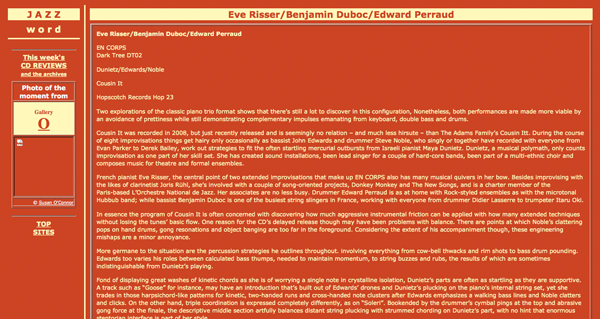• Chronique par Ken Waxman sur Jazz Word (25 décembre 2012)
Two explorations of the classic piano trio format shows that there’s still a lot to discover in this configuration, Nonetheless, both performances are made more viable by an avoidance of prettiness while still demonstrating complementary impulses emanating from keyboard, double bass and drums.
Cousin It was recorded in 2008, but just recently released and is seemingly no relation – and much less hirsute – than The Adams Family’s Cousin Itt. During the course of eight improvisations things get hairy only occasionally as bassist John Edwards and drummer Steve Noble, who singly or together have recorded with everyone from Evan Parker to Derek Bailey, work out strategies to fit the often startling mercurial outbursts from Israeli pianist Maya Dunietz. Dunietz, a musical polymath, only counts improvisation as one part of her skill set. She has created sound installations, been lead singer for a couple of hard-core bands, been part of a multi-ethnic choir and composes music for theatre and formal ensembles.
French pianist Eve Risser, the central point of two extended improvisations that make up EN CORPS also has many musical quivers in her bow. Besides improvising with the likes of clarinetist Joris Rühl, she’s involved with a couple of song-oriented projects, Donkey Monkey and The New Songs, and is a charter member of the Paris-based L’Orchestre National de Jazz. Her associates are no less busy. Drummer Edward Perraud is as at home with Rock-styled ensembles as with the microtonal Hubbub band; while bassist Benjamin Duboc is one of the busiest string slingers in France, working with everyone from drummer Didier Lasserre to trumpeter Itaru Oki.
In essence the program of Cousin It is often concerned with discovering how much aggressive instrumental friction can be applied with how many extended techniques without losing the tunes’ basic flow. One reason for the CD’s delayed release though may have been problems with balance. There are points at which Noble’s clattering pops on hand drums, gong resonations and object banging are too far in the foreground. Considering the extent of his accompaniment though, these engineering mishaps are a minor annoyance.
More germane to the situation are the percussion strategies he outlines throughout. involving everything from cow-bell thwacks and rim shots to bass drum pounding. Edwards too varies his roles between calculated bass thumps, needed to maintain momentum, to string buzzes and rubs, the results of which are sometimes indistinguishable from Dunietz’s playing.
Fond of displaying great washes of kinetic chords as she is of worrying a single note in crystalline isolation, Dunietz’s parts are often as startling as they are supportive. A track such as “Goose” for instance, may have an introduction that’s built out of Edwards’ drones and Dunietz’s plucking on the piano’s internal string set, yet she trades in those harpsichord-like patterns for kinetic, two-handed runs and cross-handed note clusters after Edwards emphasizes a walking bass lines and Noble clatters and clicks. On the other hand, triple coordination is expressed completely differently, as on “Soleri”. Bookended by the drummer’s cymbal pings at the top and abrasive gong force at the finale, the descriptive middle section artfully balances distant string plucking with strummed chording on Dunietz’s part, with no hint that enormous stentorian interface is part of her style.
More classic Free Jazz, if that expression can still be applied, the tracks on EN CORPS build to a climax, and maintain it until each player has expressed his or her alterations to the exposition. Clanking tremolo patterns, Risser’s improvising is often more percussive than Perraud’s and includes key clips and internal string strokes. Likewise Duboc’s repeated patterns rings with such strength that the others are free to indulge their most advanced ideas.
At nearly 35 minutes “trans” has the shortest title, but is the major statement here. Starting with drags and flams from the drummer and a buzzing bass line, Risser uses key jabs and tremolo cascades to intensify the tension in the exposition to such an extent that Perraud starts bomb dropping and Duboc’s plucks powerfully to keep up. Just when it appears that the pressure can become no more oppressive, the pianist reverses herself to outline gentle key sprinkles and internal string plucks. Cranking up the theme again thanks to the drummer’s clanking ruffs and paradiddles, her cascading pulses confirm she hasn’t abandoned high-frequency syncopation. At first trading licks with the pianist that literally smack the finished wood of their respective instruments, Duboc’s final sul tasto plucks lead Risser to more considerate key clicks and a moderated finale.
More mainstream pianists may insist their soloing must overly delicate à la Bill Evans and Keith Jarrett or overly domineering like Oscar Peterson’s or McCoy Tyner’s in trio settings. In contrast, both these pianists – and bands – confirm there are many other paths to follow no matter how conservative the instrumentation.
• • • • • • • • • • • • • • • • • • • • • • • • • • • • • • • • • • • • • • • • • • • • • • • • • • • • • • • • • • • • • • • •

Sorry, the comment form is closed at this time.